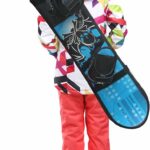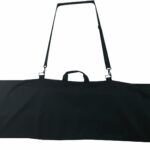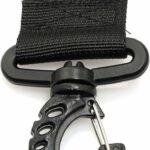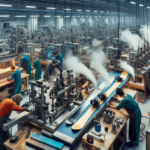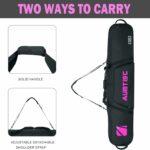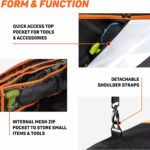Ever wondered where those sleek, shiny snowboards that grace the winter slopes are actually made? You may be surprised to know that the art of crafting these must-have winter sport accessories happens in various locations across the globe. From renowned manufacturers in Austria and the US to smaller boutique companies nestled in the snowy caps of New Zealand, the process of creating your favorite snowboard involves a meticulous balance of design, materials, and craftsmanship that is perfected in these diverse locales. Next time you strap on your board to hit the trails, take a moment to consider the journey it’s been on before it got to you.
Snowboard Manufacturing in the United States
When you think of snowboarding, you might immediately picture the snowy slopes of the US. This is not only because of its renowned snowboarding locations but also because of its significant contribution to snowboard manufacturing.
Major U.S. snowboard manufacturers
In the heartland of the US, you’ll find several key players when it comes to snowboard production. Names like Burton, Lib Tech, and GNU immediately come to mind. These manufacturers have consistently upped the game, infusing innovative technology and design elements into their gear. Burton, in particular, is famous for being a pioneer in the field, continually pushing the boundaries of what is possible in snowboarding.
Importance of local manufacturing
Local manufacturing in the US is crucial to the snowboard industry. Not only does it offer a boost to the local economies, but it also brings a certain authenticity to the products. Snowboards made in America carry the culture and spirit of American snowboarding, reflecting the diversity of its landscapes and snowboarding community. Moreover, local manufacturing allows for close oversight of the production process, ensuring the quality and consistency of the product.
Quality and characteristics of U.S.-made snowboards
US-made snowboards are widely recognized for their high quality and durability. They are made from top-notch materials and undergo a strict quality control process. They are often characterized by their innovation, as many US companies are constantly exploring new design and technological advancements.
Snowboard Manufacturing in Canada
Canada, with its rich snowboarding heritage, also occupies a significant place in the snowboard manufacturing scene.
Notable Canadian snowboard manufacturers
Canadian manufacturers like Endeavor and Prior are worth noting. With their deep understanding and love of snowboarding, these companies are creating products that truly resonate with customers. They are known to produce snowboards with impressive craftsmanship and deep attention to detail.
Canadian snowboard manufacturing process
The Canadian snowboard manufacturing process is defined by its meticulousness. Each snowboard is treated with care, undergoing a precise production cycle that ensures its quality and performance. This includes careful selection of materials, precision cutting, and design, combined with a rigorous testing phase for durability and functionality.
Recognition of Canadian snowboards globally
Canadian-made snowboards have garnered recognition on the global stage. They are valued for their performance, durability, and superb craftsmanship. Additionally, they reflect the distinctive Canadian snowboarding culture, which draws inspiration from the country’s jaw-dropping landscapes and unforgiving winters.
Snowboard Manufacturing in Europe
Europe, with its rich snow sports tradition, is a major player in snowboard manufacturing.
Predominant countries in European snowboard manufacturing
Prominent in European snowboard manufacturing are countries like Austria, Switzerland, and France. These countries, rich in snow sports history and culture, have evolved into powerhouses in snowboard production. Brands like K2, Salomon, and YES come to mind.
Distinguishable features of European-made snowboards
European-made snowboards stand out for their precision engineering and attention to detail. They often feature innovative designs, backed by extensive research and development. Many European brands also adhere to environmentally-conscious manufacturing practices, making them a popular choice among eco-conscious riders.
Leading European snowboard brands
When it comes to leading European brands, names like Amplid, Salomon, and Bataleon standout. These brands consistently produce high-quality gear that is performance-oriented yet aesthetically appealing, making them favorites among snowboarding enthusiasts worldwide.
Snowboard Manufacturing in Asia
While the Asian snowboarding scene might be less visible, Asia plays an integral role in the global snowboard manufacturing industry.
Asian countries with snowboard manufacturing
China, Taiwan, and Japan are notable for snowboard manufacturing in Asia. With their technical know-how and manufacturing capabilities, these countries have churned out high-quality snowboards that cater to a myriad of riders’ needs.
Reputation and quality of Asian-made snowboards
Asian-made snowboards have a reputation for their solid construction and affordability. They may not always come with the bells and whistles of their Western counterparts, but they deliver on functionality and value for money. For those on a budget, these snowboards are a great fit.
Asian influence on snowboard design
Asian manufacturing has had a significant influence on snowboard design. Working in tandem with Western brands, they have helped cultivate the diversity and variation seen in snowboard designs today. Brands like Bataleon have collaborated with Asia-based factories to produce their unique 3D-shaped boards, further testifying to this influence.
Materials used in Snowboard Manufacturing
Materials play a critical role in the performance and feel of a snowboard.
Common materials in snowboard construction
Commonly used materials include wood, fiberglass, steel, and plastic. The core is typically made of wood for its flexibility and strength, while fiberglass layers add stiffness and responsiveness. Steel edges provide durability, and plastic topsheets protect the snowboard from damage.
Influence of material choice on performance
The choice of material directly affects the performance of the snowboard. Higher-end models typically use lighter and more durable materials, providing better performance and longevity. The mix of materials can be manipulated to create boards with specific properties, such as more flexibility for tricks or stiffness for speed.
Sustainability concerns and material selection
Today, snowboard manufacturers are increasingly mindful of their environmental footprint, leading them to choose more sustainable materials. These include bamboo cores, recycled steel edges, and bio-based resins. These environmentally-friendly materials not only reduce the impact on the environment but also offer unique ride characteristics.
The Manufacturing Process of Snowboards
The process of making a snowboard is as fascinating as it is complex.
Steps in the snowboard manufacturing process
Manufacturing a snowboard involves several steps. It starts with designing the shape and graphics. Then, the core is shaped and sanded. Layers of fiberglass and resin are added before the snowboard is put into a press. After curing, the board is cut, edges are added, and it undergoes a final finish.
Role of technology in snowboard manufacturing
Technology has revolutionized snowboard manufacturing. Computer-aided design (CAD) allows for precise designs while automated cutting and shaping equipment improve efficiency and consistency. Innovations in material technology have also enabled the creation of lighter and more durable snowboards.
Significance of hand crafting in snowboard production
Despite technology’s role, handcrafting remains significant in snowboard production. Many manufacturers believe that a human touch brings out the soul of a snowboard. Handcrafted snowboards boast a level of craftsmanship and attention to detail that a machine can’t match, making each board a unique piece.
Influence of Design and Aesthetics in Snowboard Manufacturing
The design and aesthetics of a snowboard do more than catching your eye.
Impact of design on function and performance
The design of a snowboard significantly influences its performance. Shape, size, and curvature determine how the board handles on different terrains. For example, a wider nose and a tapered tail improve powder performance, while a symmetrical design is suitable for freestyle riding.
Role of aesthetics in snowboard appeal
Aesthetics play an undeniable role in a snowboard’s appeal. Creative graphics and bold colors can reflect a rider’s personal style and even influence buying decisions. As a result, snowboard manufacturers invest heavily in design and aesthetics, collaborating with artists and graphic designers to create visually striking boards.
Trends in snowboard design and aesthetics
Current trends in snowboard design and aesthetics include a focus on simplicity and functionality. There is a shift towards more minimalist designs, with an emphasis on clean lines and geometric shapes. However, many manufacturers also incorporate bold patterns and vibrant colors to attract younger riders.
Snowboard Manufacturing Innovations
Snowboard manufacturing has come a long way since the early days of strapping two skis together.
Innovations in materials and technology
Huge strides in material and technology have revolutionized snowboard manufacturing. From lighter and stronger materials to computer-aided design and manufacturing technologies, these innovations have led to high-performance boards that are lighter, more durable, and more responsive.
Breakthroughs in design and function
Design innovations have created snowboards tailored to specific styles and terrains. For instance, innovations like rocker profiles and 3D shaping have greatly improved a board’s performance in powder. Additionally, the introduction of asymmetric sidecut has improved carving and control, making the ride smoother and more enjoyable.
Future trends in snowboard manufacturing
Looking towards the future, trends in snowboard manufacturing point towards environmentally-friendly practices and materials. There is increased interest in sustainable manufacturing processes that reduce carbon footprint. Additionally, the integration of smart technology into snowboards, such as embedded sensors for tracking performance stats, appears to be on the horizon.
Snowboard Manufacturing and the Environment
The snowboard manufacturing process has an environmental impact that manufacturers can no longer ignore.
Environmental impact of snowboard manufacturing
Snowboard manufacturing involves the use of heavy machinery and chemical processes, which can result in carbon emissions and waste. The materials used in snowboards, such as non-renewable petroleum-based products, also pose environmental challenges.
Efforts to reduce environmental footprint
Manufacturers are making efforts to reduce their environmental footprint. This includes switching to renewable energy sources in their factories, managing waste more effectively, and sourcing eco-friendly materials. For example, some manufacturers opt for FSC-certified wood cores and bio-based resins in their snowboards.
Environmentally-friendly snowboard brands
Brands such as Patagonia, Burton, and Arbor are leading the way in sustainable snowboard manufacturing. From using recycled materials to supporting environmental causes, these brands demonstrate a commitment to minimizing their impact on the environment.
Quality Assurance in Snowboard Manufacturing
Quality assurance is crucial in ensuring that each snowboard meets the manufacturer’s standards.
Methods of quality assurance
Methods of quality assurance in snowboard manufacturing typically involve detailed inspections at different stages of the production process. This can include visual inspections, flex tests, and even on-snow testing to ensure each board performs as intended.
Role of quality assurance in the industry
Quality assurance serves a critical role in the snowboard manufacturing industry. It ensures that products meet set standards and customer expectations. A robust quality assurance program fosters trust and builds brand reputation, thus contributing to a manufacturer’s success in the marketplace.
Quality benchmarks for snowboard manufacturers
Key quality benchmarks for snowboard manufacturers involve durability, performance, and workmanship. High-quality snowboards should be able to withstand rough use over multiple seasons while delivering consistent performance. The quality of craftsmanship, seen in aspects like the finish and print quality, is also a key consideration.
So there you have it! A comprehensive look into the world of snowboard manufacturing. The next time you hit the slopes, take a moment to appreciate not just the thrill of the ride but also the craftsmanship, technology, and design that went into your snowboard.
- What Snowboard Bindings Should I Get? - January 23, 2024
- What Size Screws For Snowboard Bindings? - January 23, 2024
- How To Snowmobile On Water? - January 23, 2024

